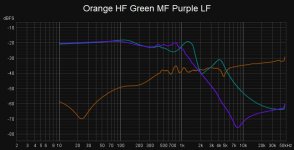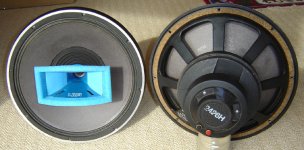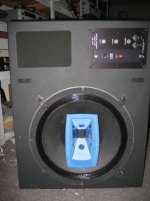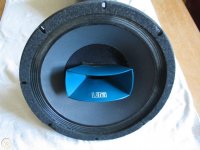Hi barboroja, the midrange can be affected because baffle step is not just a gentle reduction by six db. It depends on the baffle geometry but it can also result in aditional peaks and dips in the response.
The picture below is a baffle step model animation showing how the baffle step changes depending on the position of the driver. On an infinite baffle it would be effectively a flat line (the actual drives response notwithstanding) .
Tony.
What an awesome post. Thank you for that.
I have yet to hook them up to the Bryston due to some bad transistors. Please make sure you buy from Mouser or something alike.
Last edited:
813C was probably considered to be one of the most accurate monitor at its time, but the standard has changed. My stereo pair is still very well matched even after 40 years, but I consider 813C more like a classic speaker like Tannoy, Altec, JBL, and I feel that original analog crossover plus EQ is probably just good enough.
Can you please elaborate on how the standard has changed? My actual understanding is that studio speakers have always tried to provide most accurate and revealing presentation possible, and a lot of music from the era, made with them, still sounds like gold.
So what is the difference in SOUND if you add FIR processing? Is it an obvious or subtle change?FIR processing allows the user to adjust the frequency response and phase response independently. ie, where a conventional (IIR) crossover would introduce phase shifts, an FIR filter can be implemented without those phase shifts. If you do it right, the system will be impulse-perfect, reproduce square waves, etc.
Subtly better, but it's heading towards psychoacoustics. From what I can tell, some people are more sensitive to phase shifts than others. Those that are more sensitive will find FIR brings large benefits.
Chris
Chris
Ok guys did the measurements. Fortunately the Bryston survived the fake transistors, It was an easy fix. Obviously calibrated it for DC Offset and Bias prior to testing with the original transistors it had before.
Fed by TC interface. 700mV
Goes to Bryston Left CH.
REW using calibration file for the actual inputs and outputs loop, including the Bryston 4B NPB.
Level on the Bryston is set so output voltage is around 700mV as well.
Speakers are connected as per the manual.
Let em come.
Fed by TC interface. 700mV
Goes to Bryston Left CH.
REW using calibration file for the actual inputs and outputs loop, including the Bryston 4B NPB.
Level on the Bryston is set so output voltage is around 700mV as well.
Speakers are connected as per the manual.
Let em come.
Attachments
Can you please elaborate on how the standard has changed? My actual understanding is that studio speakers have always tried to provide most accurate and revealing presentation possible, and a lot of music from the era, made with them, still sounds like gold.
A few things have changed because of digital revolution. We can record much more low frequency energy on CD than vinyl, so more accurate bass reproduction is required. Also, noise level became lower and dynamic range got wider, but UREI has limited low level resolution and more distortion at high level. If you have a chance to compare current main stream large monitors with UREI, you'll notice that. UREI is still excellent to show big picture of the music, but the detail is not its strength, IMO.
If you play pop/rock music between 70's and early 90's, I do think UREI is one of the best speaker, and what you hear should be close to what musicians heard in the recording studios because UREI 813 was literally ubiquitous pro monitor at that time. I sometimes feel I'm sitting in the control room in 80's when I play music from that era. 🙂
Limited low level resolution?
Why?
https://www.diyaudio.com/forums/mul...e-driver-output-capability-6.html#post6277664
I tested a speaker using a sensitive microphone, and the frequency response was unchanged at levels that I couldn't hear in-room.
Chris
Why?
https://www.diyaudio.com/forums/mul...e-driver-output-capability-6.html#post6277664
I tested a speaker using a sensitive microphone, and the frequency response was unchanged at levels that I couldn't hear in-room.
Chris
I have no idea. Maybe diffraction?
All of the 604 based Altec/Urie coaxial drivers had diffraction issues due to the horn and woofer cone interaction. Take a look at the edge treatment around the horn. It's not there for show. It also helps terminate the horn.
Rob🙂
Hi Rob, 813C has a blue packaging materials permanently attached to the horn edge, and has 2 holes on the horn. I'm sure that JBL was trying to improve something from previous 813 /604 versions.
I'm sure that JBL was trying to improve something from previous 813 /604 versions.
Hello Plasnu
That I have no doubt! It's interesting to see how those Urei horns evolved over time. I used an 811C clone for my center channel for years and loved it! The vocal clarity on axis was excellent. If I ever get a chance to grab a pair of 811C's for a stereo set-up I would be very tempted.
Rob🙂
Attachments
Can't agree more. Altec is great playing vocals, and a little bit more modern UREI is no exception. I love it with mono vocal recordings such as Ella Fitzgerald or Chet Baker. It is also great for movies. Should be great center channel.
A few things have changed because of digital revolution. We can record much more low frequency energy on CD than vinyl, so more accurate bass reproduction is required. Also, noise level became lower and dynamic range got wider, but UREI has limited low level resolution and more distortion at high level. If you have a chance to compare current main stream large monitors with UREI, you'll notice that. UREI is still excellent to show big picture of the music, but the detail is not its strength, IMO.
If you play pop/rock music between 70's and early 90's, I do think UREI is one of the best speaker, and what you hear should be close to what musicians heard in the recording studios because UREI 813 was literally ubiquitous pro monitor at that time. I sometimes feel I'm sitting in the control room in 80's when I play music from that era. 🙂
Resolution means they can not play with equal detail in some scenarios? What would be the most reasonable approach to measure this?
Limited low level resolution?
Why?
https://www.diyaudio.com/forums/mul...e-driver-output-capability-6.html#post6277664
I tested a speaker using a sensitive microphone, and the frequency response was unchanged at levels that I couldn't hear in-room.
Chris
Well, that very much solves my question. Also, the manufacturers went leaps and bounds to create revealing, flat speakers, I feel the same principles are applied today.
Has speaker science really changed that much in 2x years? Or it uses the same principles? (At least the design philosophy for studio speakers)
Last edited:
barbaroja, that's a good question. I don't know how to measure it, but it's should be a combination of a lot of factors. I don't think basic principle and topology of the dynamic speaker design has changed much last 50 years. Measurable small improvements here and there, and accumulation of them has resulted audible difference, I believe.
Anyway, I would like to hear your opinion about your UREI. It's rare to have a chance to talk with the other users.
Anyway, I would like to hear your opinion about your UREI. It's rare to have a chance to talk with the other users.
- Home
- Loudspeakers
- Multi-Way
- Crossover REW Measurement for Urei 813C



